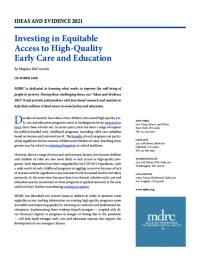Investing in Equitable Access to High-Quality Early Care and Education

MDRC is dedicated to learning what works to improve the well-being of people in poverty. During these challenging times, our “Ideas and Evidence 2021” briefs provide policymakers with fact-based research and analysis to help them address critical issues in social policy and education.
Decades of research have shown that children who attend high-quality early care and education programs arrive at kindergarten better prepared to learn than those who do not. In recent years, there has been a surge of support for publicly-funded early childhood programs, including child care subsidies based on income and universal pre-K. The benefits of such programs are particularly significant for low-income children and children of color. Enrolling these groups may be critical to reducing disparities in school readiness.
However, due to a range of structural and systemic factors, low-income children and children of color are also more likely to lack access to high-quality programs. Such disparities have been magnified by the COVID-19 pandemic, with a wide swath of early childhood programs struggling to survive because of lack of revenue and the significant costs associated with increased health and safety protocols. At the same time, because there is no formal, cohesive early care and education system, investment in these programs is applied unevenly at the state and local level, further exacerbating existing inequities.
MDRC has identified two central issues to address in order to promote more equitable access: making information on existing high-quality programs more accessible and improving quality by investing in curricula and professional development. Implementing these evidence-based strategies — coupled with direct financial support to programs in danger of closing due to the pandemic — will help build stronger early care and education systems that support the development of our youngest citizens.
Increasing Parents’ Access to Information
MDRC studies show that high-quality early care and education programs are less likely to be located in low-income neighborhoods — many of which are also communities of color — and are also less likely to offer the sort of wraparound care that parents who work full time and during nontraditional hours rely on. The studies also show that in locations where parents have access to multiple programs, the application process itself can be onerous. Parents must have up-to-date information on the application timeline; they must research numerous options and determine how to rank choices without a central source of information; and they may wait months before receiving enrollment and acceptance notifications.
The pandemic will almost certainly magnify these deep and persistent inequities. Even so, a growing number of initiatives in cities like New York City and New Orleans have shown that efforts to provide more transparent information to parents, coupled with a simplified and streamlined application process, can help promote access to high-quality programs.
Making Investments to Enhance the Quality of Existing Early Care and Education
Improved information alone is not enough. Despite bipartisan support for expanding the availability of publicly funded early care and education, research shows that investment in early learning has become even more uneven across states and localities in recent years. It is unclear if many existing programs are of sufficiently high quality to yield meaningful benefits for children.
For example, studies show that programs serving many low-income children and children of color often have lower levels of instructional quality than programs serving higher-income White children, and typically do not implement evidence-based curricula that support multiple areas of school readiness such as language, literacy, math, science, and social-emotional skills. A substantial body of research by MDRC has found that implementation of these curricula — coupled with teacher training and coaching — can substantially strengthen teacher practices, which can promote children’s academic and social-emotional development in the short and long term.
At the same time, inconsistent investment in the quality of early care and education leads to wide variations in professional development and quality standards. Without significant intervention from the federal government, these challenges are likely to be compounded by the current and future economic impacts of the pandemic.
Recommendations for the Future
In addition to providing emergency funding to early care and education programs, policymakers might consider the following recommendations:
-
In areas where multiple options are available, support efforts to provide clear and transparent information on how to choose and enroll in high-quality early care and education programs, especially to families with low incomes and families of color, who have not been well-served.
- Target evidence-based investment in the quality of early care and education — including curricula targeting key learning domains coupled with staff training and coaching — in locations where the fewest high-quality options are currently available.
There are other critical structural issues in the field of early care and education, such as the reliance on a patchwork of funding sources with varying reliability. The recommendations offered here represent evidence-based strategies that can be implemented directly through targeted investment. Importantly, the implementation and development of high-quality programs also rely on the recruitment, development, and retention of a talented early care and education workforce. An upcoming brief will provide more information on key workforce challenges facing the field and recommendations for supporting the development of high-quality early care and education teachers and staff in the years to come.
Sharon Huang, Michelle Maier, and JoAnn Hsueh contributed to this brief.






